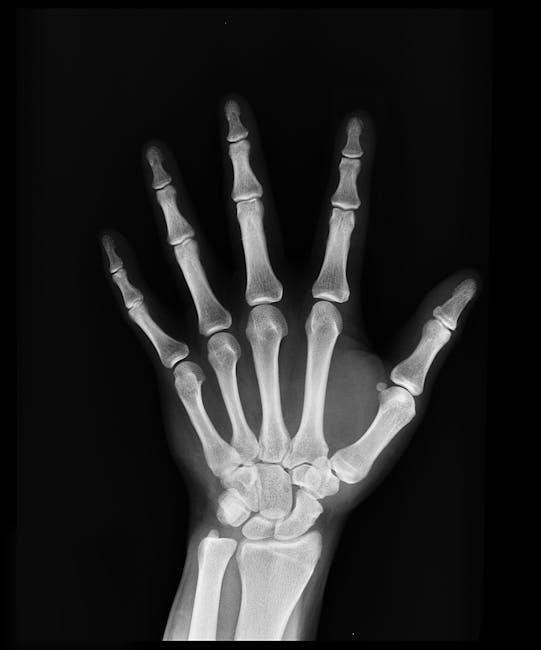Thumb sprain exercises are essential for rehabilitation, focusing on improving mobility, strength, and reducing pain. They include passive stretches, active movements, and strengthening techniques to promote recovery.
1.1 Understanding the Importance of Rehabilitation
Rehabilitation is crucial for restoring thumb function, reducing pain, and preventing future injuries. It helps improve mobility, strength, and stability, ensuring proper healing of ligaments and joints. Early mobilization and targeted exercises, such as passive stretches and strengthening techniques, are essential for a full recovery. Consistency in performing these exercises promotes long-term stability and reduces the risk of chronic pain or recurring sprains, enabling a return to daily activities and maintaining hand functionality.
1.2 Overview of Thumb Sprain Exercises
Thumb sprain exercises are designed to restore mobility, strength, and stability. They include passive stretches, active movements, and strengthening techniques. Passive exercises involve gentle stretches using the uninjured hand, while active exercises focus on thumb bending, spreading, and pinching. Resistance tools like bands or putty enhance strength. These exercises improve joint stability, reduce pain, and promote functional recovery. Consistent practice ensures proper healing and prevents future injuries, helping patients regain full thumb functionality and return to daily activities effectively.

Understanding Thumb Sprain Injuries
A thumb sprain involves ligament stretching or tearing, causing pain and instability. It often results from accidents or falls, leading to swelling and limited mobility.
2.1 What is a Thumb Sprain?
A thumb sprain occurs when ligaments in the thumb joint are stretched or torn, often due to accidents or falls. This injury causes pain, swelling, and limited mobility. It can range from mild to severe, impacting daily activities. Prompt treatment is essential to prevent further complications and ensure proper healing.
2.2 Common Causes of Thumb Sprains
Thumb sprains often result from accidents, falls, or sports injuries. Activities like skiing or basketball can lead to thumb injuries. Falling onto an outstretched hand or direct impact on the thumb can cause ligament stress. Overuse or repetitive motions may also contribute. Understanding these causes helps in preventing future injuries and guides effective treatment strategies.
2.3 Symptoms and Diagnosis
Common symptoms of a thumb sprain include pain, swelling, tenderness, and limited movement. Diagnosis typically involves a physical exam to assess thumb stability and mobility. Imaging tests like X-rays or MRIs may be used to rule out fractures or severe ligament tears. Early and accurate diagnosis is crucial for proper treatment and recovery. A healthcare professional will evaluate the severity to determine the appropriate rehabilitation plan.

The Role of Early Rehabilitation
Early rehabilitation helps prevent stiffness, promotes healing, and enhances recovery by maintaining thumb mobility and strength, reducing long-term impairment and restoring functional use.
3;1 Benefits of Early Mobilization
Early mobilization after a thumb sprain prevents stiffness, promotes healing, and enhances recovery. It improves joint mobility, strengthens muscles, and reduces pain. Gentle exercises maintain flexibility and stability, preventing long-term impairment. Consistent practice ensures faster return to normal activities, minimizing the risk of chronic issues. Early movement also boosts blood flow, aiding tissue repair. Professional guidance is crucial to avoid overexertion, ensuring a safe and effective recovery process.
3.2 Setting Realistic Recovery Goals
Setting realistic recovery goals is crucial for a successful rehabilitation journey. Goals should be tailored to the severity of the injury and individual lifestyle. Tracking progress helps maintain motivation and ensures exercises are performed correctly. Celebrating small milestones, like regaining basic thumb movement, boosts confidence. Consistency is key, as recovery takes time. Professional guidance helps set achievable targets, ensuring a safe and effective return to full functionality. Realistic goals prevent frustration and promote long-term success.

Passive Thumb Exercises
Passive thumb exercises involve using the uninjured hand to gently move the injured thumb through its range of motion, improving flexibility and reducing stiffness without active muscle engagement.
4.1 Passive Range of Motion (PROM) Exercises
Passive Range of Motion (PROM) exercises involve gently moving the thumb through its full range of motion without active muscle engagement. These exercises help maintain joint flexibility and prevent stiffness. Using the uninjured hand, slowly bend and straighten the thumb, focusing on the tip and knuckle joints. Hold each stretch for 30 seconds and repeat 4 times daily. This technique is especially beneficial in the early stages of recovery to promote healing and restore mobility.
4.2 Thumb Blocking Exercises
Thumb blocking exercises involve using the uninjured hand to gently bend the injured thumb across the palm. This technique helps improve joint mobility and reduces stiffness. Start by bending the thumb tip downward until a mild stretch is felt, then release. Repeat this motion for both thumb joints, ensuring smooth and controlled movements. Perform these exercises 3-4 times daily to enhance flexibility and promote early recovery without causing additional strain on the injured thumb.
4.3 Stretching Techniques for Flexibility
Stretching techniques for thumb flexibility focus on improving joint mobility and reducing stiffness. Gently bend the thumb across the palm, holding for 30 seconds, and repeat 4 times daily. Dynamic stretches, such as slow circular motions, can also enhance flexibility. These exercises should be performed smoothly, avoiding pain, to promote recovery and restore natural thumb movement. Consistency is key to achieving long-term flexibility and reducing the risk of future injuries.
Active Thumb Exercises
Active thumb exercises involve movements like bending, straightening, and spreading to improve mobility and strength. These exercises enhance flexibility and promote recovery without external assistance.
5.1 Thumb Bending and Straightening
Thumb bending and straightening exercises involve gently moving the thumb from a straight position to a bent one, repeating the motion. This improves joint mobility and strength. Perform 10-15 repetitions, 3-4 times daily. Start slowly, increasing as comfort allows. This exercise helps restore normal movement and reduces stiffness after a sprain. It’s essential to maintain a smooth, controlled motion to avoid further strain.
5.2 Thumb Spreads and Pinches
Thumb spreads involve moving the thumb away from the palm and back, enhancing range of motion and strength. Pinch exercises, like squeezing putty or a soft ball, improve gripping ability. Start with 10 repetitions of each, gradually increasing as comfort allows. These exercises strengthen the thumb’s intrinsic muscles and improve dexterity. Perform 3-4 sets daily, focusing on slow, controlled movements to avoid strain and promote proper healing. Consistency helps restore functional grip and overall thumb mobility effectively.
5.3 Resistance Exercises for Strength

Resistance exercises, such as using therapy putty or resistance bands, are key for strengthening the thumb after a sprain. These exercises target the intrinsic muscles, improving grip and stability. Start with gentle resistance and gradually increase intensity. Focus on slow, controlled movements to avoid strain. Perform 3-4 sets of 10-15 repetitions daily. Avoid causing pain; stop if discomfort occurs. Regular practice enhances strength, restoring functional grip and promoting independence in daily activities. Consistency is crucial for long-term recovery and preventing future injuries.

Strengthening Exercises for the Thumb
Thumb strengthening exercises, such as using thumb putty or resistance bands, improve grip strength and stability. These exercises target intrinsic muscles, enhancing functional recovery and overall dexterity effectively.
6.1 Thumb Putty Exercises
Thumb putty exercises are effective for strengthening the thumb muscles. Sit with your hand flat, place a small piece of putty between your thumb and index finger. Slowly squeeze the putty, holding for 3-5 seconds, then release. Repeat 10-15 times, 2-3 times daily. This exercise targets intrinsic thumb muscles, improving grip strength and dexterity. As strength increases, gradually use firmer putty. Consistency is key for optimal recovery and functional improvement in thumb mobility and stability.
6.2 Resistance Band Workouts
Resistance band workouts are excellent for enhancing thumb strength and stability. Loop the band around your thumb, anchoring the other end to a stable object. Gently pull the band to create resistance, then release slowly. Perform 3 sets of 10-12 repetitions daily. This exercise targets the thumb’s flexor and extensor muscles, improving grip strength and joint stability. Start with light resistance and gradually increase as strength improves. Consistency is key to achieving optimal recovery and functional improvement in thumb mobility and overall hand function.
6.3 Intrinsic Muscle Strengthening
Intrinsic muscle strengthening focuses on the small muscles within the thumb itself. Exercises like thumb extensions, spreads, and oppositions help improve grip and dexterity. Use tools like thumb putty or resistance bands to add challenge. Perform 3 sets of 10-15 repetitions daily. These exercises enhance thumb stability, reduce pain, and restore functional movement. Consistency is crucial for rebuilding strength and achieving long-term recovery. Start slowly and progress as comfort allows to avoid overexertion and promote healing.
Stretching Exercises for Thumb Mobility
Stretching exercises improve thumb mobility and reduce stiffness. Techniques include bending the thumb down or across the palm, holding stretches for 30 seconds, and repeating 4 times daily.
7.1 Stretching the Thumb Joint
Stretching the thumb joint involves gently bending the thumb downward or across the palm. Hold each stretch for 30 seconds, repeating 4 times daily. This helps improve flexibility and reduce stiffness. Use your uninjured hand to assist if needed, focusing on the base of the thumb. Perform stretches slowly and avoid bouncing to prevent further injury. Regular stretching promotes healing and restores normal thumb movement, essential for daily activities and grip strength.
7.2 Stretching the Thumb Knuckle
Stretching the thumb knuckle targets the joint at the base of the thumb. Gently press the knuckle downward with your other hand until a mild stretch is felt. Hold for 30 seconds, repeating 4 times daily. This exercise improves flexibility and reduces stiffness in the knuckle, enhancing thumb mobility. Perform slowly and avoid force to prevent discomfort. Regular stretching helps restore normal thumb movement and grip strength, aiding in recovery from sprains and improving overall hand function.
7.3 Dynamic Stretching Techniques
Dynamic stretching involves moving the thumb through its range of motion while maintaining gentle, controlled movements. Examples include thumb circles, bends, and spreads. Perform these exercises slowly, holding each position for 5-10 seconds. Repeat 10-15 times per session. Dynamic stretches improve joint mobility and reduce stiffness without causing pain. Incorporate resistance bands or putty for added challenge. These techniques are ideal for advancing mobility and strength in the thumb during the later stages of recovery from a thumb sprain.

Advanced Thumb Exercises
Advanced exercises focus on complex movements like thumb opposition, functional activities, and progressive resistance to enhance dexterity and strength, ensuring full recovery from a thumb sprain.
8.1 Thumb Opposition Exercises
Thumb opposition exercises involve touching the tip of the thumb to each fingertip sequentially. This enhances dexterity and strength. Start with the index finger, then middle, ring, and pinky. Use the other hand for gentle resistance. Perform 3 sets of 10 repetitions daily. Focus on slow, controlled movements to maximize benefit. This exercise improves grip and functional ability, crucial for daily activities. Regular practice helps restore thumb function and coordination after a sprain.
8.2 Functional Activities for Recovery
Functional activities mimic daily tasks to restore thumb function. Examples include gripping utensils, typing, or buttoning clothes. These exercises improve coordination and practical use. Start with light activities like holding a spoon or pen, progressing to more complex tasks. Incorporate activities that simulate work or hobbies to enhance recovery. Gradually increase difficulty as strength and mobility improve. Consistent practice helps reintegrate the thumb into daily life, promoting independence and reducing reliance on assistive devices.
8.3 Progressing to Complex Movements
As recovery advances, introduce complex movements to enhance thumb function. Examples include multi-planar motions, such as twisting or diagonal patterns, and combined actions with fingers. These exercises mimic real-life tasks, improving dexterity and coordination. Gradually increase difficulty by adding resistance or speed. Focus on precise movements to avoid re-injury. Incorporate activities like turning keys or handling small objects to simulate daily challenges. Proper form and controlled progression are key to rebuilding advanced thumb functionality and preparing for unrestricted use.
Pain Management and Exercise
Managing pain during thumb sprain rehabilitation is crucial to avoid further injury. Use ice therapy to reduce swelling and discomfort. Perform gentle exercises within a pain-free range to promote healing without aggravating the injury.
9.1 Managing Pain During Rehabilitation
Managing pain during thumb sprain rehabilitation is essential to ensure effective recovery. Apply ice therapy to reduce swelling and discomfort. Perform exercises slowly, stopping if pain increases. Use pain as a guide to avoid overexertion. Gentle stretches and strengthening exercises can help alleviate discomfort while promoting healing. Over-the-counter pain relievers may be used under medical guidance. Prioritize pain-free movements to prevent further injury and support the recovery process.
9.2 Incorporating Ice and Heat Therapy
Ice therapy helps reduce swelling and pain during the initial stages of thumb sprain recovery. Apply ice for 15-20 minutes, several times a day. Heat therapy, such as warm compresses, can be introduced later to improve blood flow and reduce stiffness. Alternate between ice and heat as needed, ensuring the skin is protected with a cloth barrier. Avoid heat during the acute phase, as it may worsen inflammation. Always consult a therapist for personalized advice on therapy timing and application.
9.3 Pain-Free Exercise Techniques

Pain-free exercises are crucial for thumb sprain recovery, ensuring progress without aggravating the injury. Start with gentle stretches and gradual resistance, avoiding movements that cause discomfort. Use techniques like thumb bending, spreading, and pinching with minimal force. If pain occurs, stop the exercise immediately. Incorporate supports, such as splints, to stabilize the thumb during workouts. Perform exercises slowly and smoothly to maintain control and prevent strain. Always prioritize pain-free movements to promote healing and avoid setbacks in rehabilitation.

Preventing Future Thumb Injuries
Preventing thumb injuries involves strengthening muscles, improving joint stability, and maintaining proper alignment. Regular exercises and ergonomic practices reduce the risk of future sprains and strains effectively.
10;1 Strengthening for Injury Prevention
Strengthening exercises are crucial for preventing future thumb injuries. Using thumb putty or resistance bands can enhance muscle endurance and joint stability. Regular practice of intrinsic muscle exercises improves grip strength and reduces the risk of sprains. Consistent strengthening routines help maintain proper thumb alignment and functionality, minimizing the likelihood of re-injury. Incorporating these exercises into daily routines ensures long-term thumb health and resilience against potential strains or sprains.
10.2 Improving Joint Stability
Improving joint stability is vital for preventing thumb sprains and ensuring proper function. Thumb blocking and opposition exercises enhance ligament support and joint alignment. Using resistance bands or putty strengthens the muscles around the thumb joint, promoting stability. Consistent practice of these exercises helps maintain joint integrity, reducing the risk of future injuries. Regular strengthening routines also improve proprioception, which is essential for maintaining joint stability during daily activities and sports.
10.4 Maintaining Proper Thumb Alignment
Maintaining proper thumb alignment is crucial for preventing reinjury and ensuring optimal function. Using a splint or taping during exercises can help stabilize the thumb. Gentle stretching and strengthening exercises, such as thumb extensions and spreads, promote proper alignment. Avoiding overextension or awkward positions reduces strain on the joint. Consistent practice of alignment-focused exercises helps restore natural thumb positioning, enhancing grip strength and dexterity while minimizing the risk of future sprains.

When to Seek Professional Help
Seek professional help if experiencing severe pain, swelling, or limited thumb movement. Consult a hand therapist for personalized guidance, especially after surgery or for persistent symptoms.
11.1 Signs of Severe Injury
Signs of a severe thumb injury include intense pain, significant swelling, bruising, or inability to move the thumb. If there’s numbness, tingling, or an inability to grip, seek immediate medical attention. A severe sprain may involve ligament tears, such as the ulnar collateral ligament (UCL), often called “skier’s thumb.” These injuries require professional evaluation to prevent long-term damage or chronic instability. Early intervention ensures proper healing and restores thumb function effectively.
11.2 Consulting a Hand Therapist
A hand therapist specializes in treating thumb injuries, offering personalized exercises and treatments. They can create custom splints, improve joint mobility, and strengthen muscles. Consulting a therapist is crucial for severe sprains, especially if home exercises aren’t effective. They can address complex issues like ligament tears or chronic pain, ensuring proper healing and function. A therapist’s expertise helps prevent long-term instability and restores full thumb mobility, making them an essential part of recovery for severe injuries.
11.3 Post-Surgery Rehabilitation
Post-surgery rehabilitation for thumb sprains focuses on restoring strength, mobility, and function. Gentle exercises, like passive range of motion, are introduced early to prevent stiffness. A hand therapist may design a personalized program, including splinting and pain management. Progression to active movements and strengthening exercises follows as healing advances. The goal is to regain full thumb functionality, ensuring proper alignment and stability. Regular follow-ups with the therapist are crucial to monitor progress and adapt the rehabilitation plan as needed for optimal recovery.
Thumb sprain exercises are crucial for recovery, improving mobility, strength, and flexibility. Consistent practice and professional guidance ensure optimal healing and long-term thumb functionality.
12.1 Summary of Key Exercises
The key exercises for thumb sprain recovery include thumb bending, straightening, and spreads, as well as pinches and resistance band workouts. Passive stretches, like PROM and thumb blocking, improve flexibility. Intrinsic muscle strengthening and dynamic techniques enhance mobility. Advanced exercises, such as thumb opposition and functional activities, promote complex movements. Consistency and gradual progression are essential for optimal recovery. Always consult a professional to tailor exercises to individual needs and ensure proper technique.
12.2 Long-Term Recovery Tips
For long-term recovery, maintain consistent exercise routines to preserve thumb mobility and strength. Avoid repetitive strain and overuse to prevent reinjury. Incorporate daily stretches and strengthening exercises into your routine; Use ergonomic tools to reduce stress on the thumb during daily activities. Monitor progress and adjust exercises as needed. Prioritize proper alignment and technique to ensure lasting stability and function. Regularly consult with a hand therapist to maintain optimal recovery and prevent future issues.
